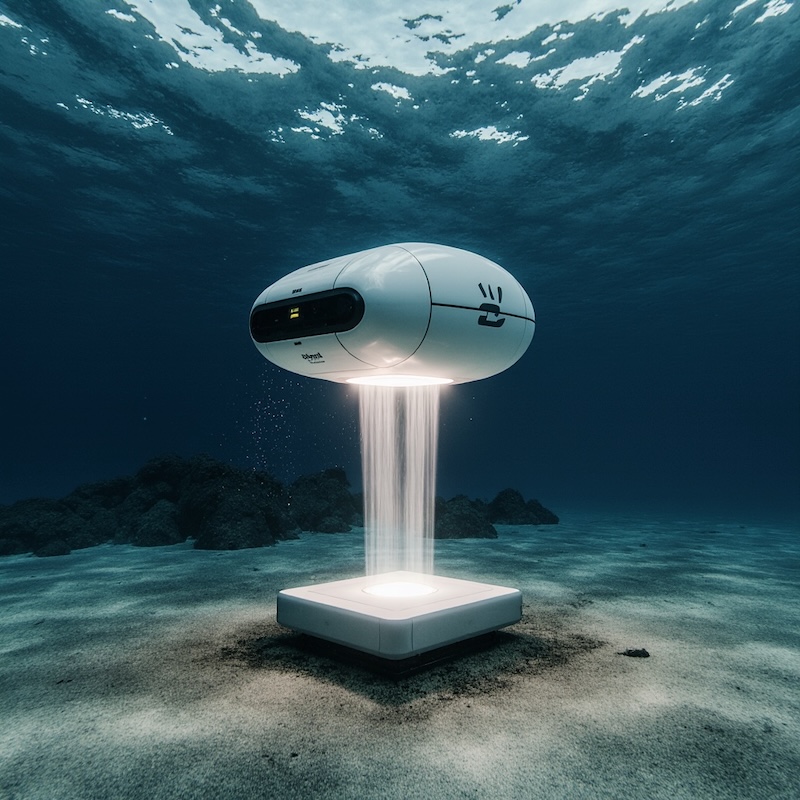
A recent research presents a hybrid magnetic coupler–based wireless power transfer system for autonomous underwater vehicles (AUVs) that maintains high efficiency and stable 300W output despite significant misalignments in rotation, tilt, and position.
Autonomous Underwater Vehicles (AUVs) are the deep-sea explorers of our time 🌊🤖. Whether they’re mapping the ocean floor, monitoring ecosystems, or collecting samples, one thing’s for sure—they need reliable power. And that’s not so easy when you’re 3,000 meters underwater.
Traditional recharging methods like manual battery swapping or plug-in charging require a lot of human effort and are prone to wear and tear. Enter Wireless Power Transfer (WPT)—a contactless, smart, and safe way to recharge an AUV, even without perfect alignment. But until now, misalignment issues have held this tech back.
A recent breakthrough paper introduces a strong misalignment-tolerant wireless power system using a clever hybrid magnetic coupler design. And the results? 🤯 Ultra-stable 300W power output with more than 92% efficiency, even when coils are totally rotated or misaligned.
Let’s dive in 🐠…
In underwater environments, Wireless Power Transfer systems face three big types of misalignments:
These errors disrupt the magnetic coupling between transmitter and receiver coils, slashing power delivery and efficiency. Many designs have tried to fix this, but they often only handle one type of misalignment and still suffer serious performance drops.
The authors propose a Hybrid Magnetic Coupler that changes the game! 🌟
Instead of relying on just one type of coil, their system uses a combo of arc-shaped and solenoid coils on the AUV's side:
Think of it like using a wide fishing net 🎣 instead of a hook—you’re going to catch a lot more energy even if you’re off-target.
🧪 The goal? Maintain strong coupling even when the AUV is rotated 180°, shifted up to 40 mm, or tilted at 15°. Spoiler: it works!
To ensure their coupler works under tough underwater conditions, the team ran simulations and experiments to tweak parameters like:
Using COMSOL software, they optimized:
✅ Best setup found:
This combo balanced strong coupling with minimal sensitivity to misalignment.
Inside the system is an LCC-S circuit topology, a special arrangement of capacitors and inductors that ensures:
This setup keeps current stable even as misalignment changes, like a smart cruise control system for power ⚡️.
In lab experiments with a 300W prototype:
📉 Overall degradation from perfect alignment? Just 1–2%—a huge win!
💡 Bonus: Even when switching the electrical load mid-operation, the system kept the voltage stable and adjusted current automatically.
Great question! Seawater does cause eddy current losses, reducing efficiency slightly. But since the system operates at a relatively low 85 kHz, those losses are small.
💧 Studies estimate just 1–2% degradation going from air to water.
So yes, this system is underwater-ready 🧜.
This hybrid magnetic coupler has big potential beyond AUVs:
The authors hint at next steps like:
Imagine a world where your deep-sea robot never needs to come back up to recharge… that’s the dream this research is building.
With its hybrid coil design, smart LCC-S circuitry, and rock-solid performance under misalignment, this Wireless Power Transfer system sets a new benchmark for powering underwater vehicles.
🧲 No more precision docking.
🌊 No more salty plugs.
🚀 Just clean, reliable power—no matter the angle.
In the world of wireless power, this research is a giant leap forward.
📡 Wireless Power Transfer (WPT) - A way to send electricity from one device to another without wires, using magnetic fields—kind of like charging your phone on a wireless pad, but for robots and vehicles. - More about this concept in the article "🔌 Zap Your Gadgets from Anywhere: The Eight-Coil Revolution in Wireless Charging! ⚡".
🧲 Magnetic Coupler - A special coil system that lets magnetic energy flow between the power source and receiver—think of it as a magnetic handshake that powers devices.
🐟 Autonomous Underwater Vehicle (AUV) - A robot submarine that explores the ocean on its own, often used for deep-sea research, inspection, and mapping—no cables, no crew. - More about this concept in the article "Dive Smart 🐬 How AUVs Are Revolutionizing Underwater Data Collection!".
🔄 Misalignment - When the power-sending coil and power-receiving coil aren’t perfectly lined up, causing power transfer to drop—like missing the sweet spot on a wireless charger.
↪️ Rotational Misalignment - When the AUV is angled or turned the wrong way, so the coils don’t face each other correctly.
↕️ Axial Misalignment - When the AUV is too high or low above the charger, making the magnetic connection weaker.
🔀 Tilt Misalignment - When the AUV is tilted (not flat), affecting how the magnetic fields connect.
🔃 Coupling Coefficient (k) - A number between 0 and 1 that tells how much energy is being transferred from the sender to the receiver—higher means better power flow.
📉 Mutual Inductance (M) - A measure of how well magnetic energy from one coil induces (creates) voltage in the other—it’s what makes wireless charging possible.
🔋 LCC-S Compensation Topology - A smart circuit setup that keeps power flowing smoothly—even when things get misaligned—by tuning coils and capacitors to work in sync.
Source: Wen, H.; Zhou, X.; Wang, Y.; Yan, Z.; Zhang, K.; Wen, J.; Yang, L.; Zhao, Y.; Liu, Y.; Tong, X. A Strong Misalignment Tolerance Wireless Power Transfer System for AUVs with Hybrid Magnetic Coupler. J. Mar. Sci. Eng. 2025, 13, 1423. https://doi.org/10.3390/jmse13081423
From: Xi’an University of Technology; Northwestern Polytechnical University; Xi’an Weiguang Energy Technology Co., Ltd..